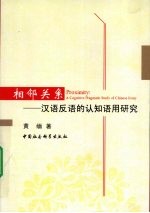图书介绍
相邻关系 汉语反语的认知语用研究PDF|Epub|txt|kindle电子书版本网盘下载

- 黄缅著 著
- 出版社: 北京:中国社会科学出版社
- ISBN:9787500477037
- 出版时间:2009
- 标注页数:266页
- 文件大小:28MB
- 文件页数:279页
- 主题词:汉语-认知科学:语用学-研究
PDF下载
下载说明
相邻关系 汉语反语的认知语用研究PDF格式电子书版下载
下载的文件为RAR压缩包。需要使用解压软件进行解压得到PDF格式图书。建议使用BT下载工具Free Download Manager进行下载,简称FDM(免费,没有广告,支持多平台)。本站资源全部打包为BT种子。所以需要使用专业的BT下载软件进行下载。如BitComet qBittorrent uTorrent等BT下载工具。迅雷目前由于本站不是热门资源。不推荐使用!后期资源热门了。安装了迅雷也可以迅雷进行下载!
(文件页数 要大于 标注页数,上中下等多册电子书除外)
注意:本站所有压缩包均有解压码: 点击下载压缩包解压工具
图书目录
Chapter 1 Introduction1
1.1 Preliminary remarks1
1.2 The commitment of the study4
1.3 The story of irony6
1.3.1 Origin6
1.3.2 Irony in Chinese context7
1.3.3 Classification11
1.3.4 Uses and functions16
1.3.5 Summary of the section21
1.4 Scope of the study22
1.5 Methodological issues22
1.5.1 Lead-in remarks22
1.5.2 Research phases24
1.6 Data25
1.7 Structure of the dissertation26
1.8 Summary27
Chapter 2 Literature Review29
2.1 Introduction29
2.2 Historical survey30
2.2.1 Greek30
2.2.2 Latins33
2.2.3 Mediaeval and Renaissance35
2.2.4 Early modern times38
2.2.5 Modern times40
2.2.6 Brief summary44
2.3 Theoretical survey abroad45
2.3.1 Initial remarks45
2.3.2 Non-cognitive-pragmatic studies45
2.3.3 Cognitive-pragmatic studies49
2.3.4 Summary60
2.4 Research in Chinese context67
2.4.1 Preliminaries67
2.4.2 Chronological survey69
2.5 Remaining crucial problem75
2.6 Summary76
Chapter 3 Theoretical Framework77
3.1 Preliminaries77
3.2 Methodological constraints79
3.3 Theoretical background of the present study81
3.3.1 Main assumptions of cognitive linguistics82
3.3.2 A brief survey of cognitive pragmatics88
3.3.3 Theories of human cognitive abilities94
3.4 Towards a unified theoretical framework118
3.4.1 MM-based pragmatic reasoning119
3.4.2 Explicit expression-implicit expression inference125
3.4.3 Autonomy-dependence alignment128
3.5 Summary133
Chapter 4 Issues of Definition and Taxonomy Revisited136
4.1 Introduction136
4.2 Definitions of irony revisited137
4.2.1 Initial remarks137
4.2.2 Classical identification138
4.2.3 Modifications140
4.2.4 Definitions in Chinese context142
4.3 Three claims reconsidered143
4.4 Working definition of fan yu146
4.5 Classification revisited148
4.6 Taxonomy of verbal irony152
4.6.1 Positive attitude irony154
4.6.2 Negative attitude irony161
4.7 Summary170
Chapter 5 Irony as a cognitive-pragmatic phenomenon172
5.1 Introduction172
5.2 Chinese irony and its pragmatic features174
5.2.1 Speaker's intention174
5.2.2 Cancellability176
5.2.3 Pragmatic vagueness177
5.2.4 Contextual constraints179
5.2.5 Indirect communicative act184
5.3 Chinese irony and its pragmatic functions186
5.3.1 Sarcasm187
5.3.2 Politeness188
5.3.3 Intimacy191
5.3.4 Humor191
5.3.5 Praise192
5.4 Irony seen from the cognitive perspective193
5.4.1 The cognitive traits of irony194
5.4.2 Proximity cognition underlying irony197
5.5 Irony:cognitive-pragmatic interface200
5.6 Summary202
Chapter 6 Mechanism of the Use of irony Redescribed203
6.1 Introduction203
6.2 Further description of the underlying mechanism204
6.3 Interpretation of irony209
6.3.1 Process of interpretation of irony209
6.3.2 Analyses of examples213
6.4 Production of irony219
6.4.1 Process of production of irony219
6.4.2 Analyses of some examples222
6.5 Summary224
Chapter 7 Conclusion228
7.1 Introduction228
7.2 Findings and conclusions229
7.3 Implications231
7.4 Limitations of our work233
7.5 Suggestions for further study235
Dictionaries and Encyclopedias Referred237
Bibliography238
Index257
后记266
Figure 3-1 Construal of Realities through Conceptualization87
Figure 3-2 Law of Proximity110
Figure 3-3 Law of Closure110
Figure 3-4 Law of Symmetry111
Figure 3-5 Figure-Ground Segregation111
Figure 3-6 Law of Continuity112
Figure 3-7 Law of Similarity112
Figure 3-8 Different Degrees of Similarity among Three Groups114
Figure 3-9 Opposite Direction Continuum for Physical Appearance115
Figure 3-10 Two-Direction Processes of Language Use119
Figure 3-11 Explicit Expression-Implicit Expression Inferential Process127
Figure 3-12 Autonomy-Dependence Alignment133
Figure 3-13 Mechanism Underlying the Use of Irony134
Figure 4-1 Continuum of Two-Opposite-Direction Meanings of Irony145
Figure 4-2 Taxonomy offan yu(Chinese irony)154
Figure 6-1 Two-Stage Process of Irony Comprehension210